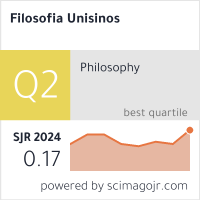On truth as the source of good: An is/ought reinterpretation
DOI:
https://doi.org/10.4013/5023Resumen
Chinese and western philosophies tend to give different answers to is/ought relation. The disputes provide a broader vision to make a reexploration into the old and fruitful question. Clear distinctions between the subjective fact judgment and the objective fact, between the subjective value judgment and the objective value are the prerequisite. A subjective fact judgment, an is statement, consists of two elements: the judging person or power, and the judged object, i.e. the objective fact. It is the judged object itself that works as the criterion for the true or false of the fact judgment. A subjective value judgment, or an ought statement, consists of three elements: the judging person or power, the judged object or the objective fact, and the third element, which is something other than the judged object and works as the criterion for the making of the good or evil judgment. The third element in the value judgment is the core in the is/ought distinction and also the source of ought. Further analyses into the third elements under different types of value judgments show that this source of ought is fundamentally and essentially factual. The relation of fitness objectively existing between the judged object and the third element is found to be the ultimate factual foundation of value judgment. A final reunification of is and ought is achieved at the factual relation of fitness while the difference between is/ought lies only in the perspectives to depict the relation. So, fundamentally, ought can only be derived from is while the good flows from the truth. Such a conclusion accepts the Chinese connection thesis between is and ought, but rejects its emphasis of good over truth.
Key words: Is/ought, two-element judgment/three-element judgment, the third element, truth/good.Descargas
Métricas
Descargas
Publicado
Cómo citar
Número
Sección
Licencia
Concedo a revista Filosofia Unisinos – Unisinos Journal of Philosophy o direito de primeira publicação da versão revisada do meu artigo, licenciado sob a Licença Creative Commons Attribution 4.0 (que permite o compartilhamento do trabalho com reconhecimento da autoria e publicação inicial nesta revista).
Afirmo ainda que meu artigo não está sendo submetido a outra publicação e não foi publicado na íntegra em outro periódico e assumo total responsabilidade por sua originalidade, podendo incidir sobre mim eventuais encargos decorrentes de reivindicação, por parte de terceiros, em relação à autoria do mesmo.










